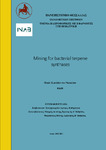Πλοήγηση ανά Θέμα "Actinobacteria"
Αποτελέσματα 1-20 από 20
-
Ancestral Absence of Electron Transport Chains in Patescibacteria and DPANN
(2020)Recent discoveries suggest that the candidate superphyla Patescibacteria and DPANN constitute a large fraction of the phylogenetic diversity of Bacteria and Archaea. Their small genomes and limited coding potential have ... -
Assessment of the effects of oxamyl on the bacterial community of an agricultural soil exhibiting enhanced biodegradation
(2019)Modern agricultural practices largely rely on pesticides to protect crops against various pests and to ensure high yields. Following their application to crops a large amount of pesticides ends up in soil where they may ... -
Bacterial Communities and Antibiotic Resistance of Potential Pathogens Involved in Food Safety and Public Health in Fish and Water of Lake Karla, Thessaly, Greece
(2022)Bacterial communities, microbial populations, and antibiotic resistance of potential pathogens in the water and fish (Cyprinus carpio, flesh and gut) from different areas (A1, A2 and A3—A1 was linked with river water, A2 ... -
Bioaugmentation of thiabendazole-contaminated soils from a wastewater disposal site: Factors driving the efficacy of this strategy and the diversity of the indigenous soil bacterial community
(2018)The application of the fungicide thiabendazole (TBZ) in fruit packaging plants (FPP) results in the production of effluents which are often disposed in adjacent field sites. These require remediation to prevent further ... -
Biotreatment and bacterial succession in an upflow immobilized cell bioreactor fed with fludioxonil wastewater
(2021)The large quantities and the persistent nature of fungicide wastewaters have increased the efforts towards a sustainable technological solution. In this context, fludioxonil-contaminated wastewater was treated in an upflow ... -
Blame it on the metabolite: 3,5-dichloroaniline rather than the parent compound is responsible for the decreasing diversity and function of soil microorganisms
(2018)Pesticides are key stressors of soil microorganisms with reciprocal effects on ecosystem functioning. These effects have been mainly attributed to the parent compounds, while the impact of their transformation products ... -
Effects of sheep bone biochar on soil quality, maize growth, and fractionation and phytoavailability of Cd and Zn in a mining-contaminated soil
(2021)Biochar prepared from various feedstock materials has been utilized in recent years as a potential stabilizing agent for heavy metals in smelter-contaminated soils. However, the effectiveness of animal bone-derived biochar ... -
Green remediation of toxic metals contaminated mining soil using bacterial consortium and Brassica juncea
(2021)Microorganism-assisted phytoremediation is being developed as an efficient green approach for management of toxic metals contaminated soils and mitigating the potential human health risk. The capability of plant growth ... -
Gut microbial communities associated with the molting stages of the giant freshwater prawn Macrobrachium rosenbergii
(2016)The reciprocal interaction between host organisms' physiology and their gut microorganism community is of great interest in aquatic animal biology and aquaculture but for crustaceans, it remains understudied. This study ... -
Host species determines the composition of the prokaryotic microbiota in phlebotomus sandflies
(2020)Phlebotomine sandflies are vectors of the humans’ and mammals’ parasite Leishmania spp. Although the role of gut microbiome in the biological cycle of insects is acknowledged, we still know little about the factors modulating ... -
Lab to field assessment of the ecotoxicological impact of chlorpyrifos, isoproturon, or tebuconazole on the diversity and composition of the soil bacterial community
(2018)Pesticides are intentionally applied to agricultural fields for crop protection. They can harm non-target organisms such as soil microorganisms involved in important ecosystem functions with impacts at the global scale. ... -
Microbiome in multiple sclerosis; where are we, what we know and do not know
(2020)An increase of multiple sclerosis (MS) incidence has been reported during the last decade, and this may be connected to environmental factors. This review article aims to encapsulate the current advances targeting the study ... -
Molecular diversity of bacteria in commercially available "Spirulina" food supplements
(2016)The cyanobacterium Arthrospira is among the most well-known food supplements worldwide known as "Spirulina." While it is a widely recognized health-promoting natural product, there are no reports on the molecular diversity ... -
Nicosulfuron application in agricultural soils drives the selection towards NS-tolerant microorganisms harboring various levels of sensitivity to nicosulfuron
(2016)The action mode of sulfonylurea herbicides is the inhibition of the acetohydroxyacid synthase (AHAS) required for the biosynthesis of amino acids valine and isoleucine in plants. However, this enzyme is also present in a ... -
Olive mill wastewater affects the structure of soil bacterial communities
(2010)Land spreading of olive mill wastewater (OMW) has beets proposed as a useful means for its disposal. However, there is no information regarding the impact of OMW soil applications on the structure of bacterial communities. ... -
Reshaping gut bacterial communities after dietary Tenebrio molitor larvae meal supplementation in three fish species
(2019)The aquaculture industry is currently looking for alternative, sustainable diets that provide similar or better growth for the reared species. We investigated whether replacing fishmeal with yellow mealworm (Tenebrio ... -
Role of microbial diversity for sustainable pyrite oxidation control in acid and metalliferous drainage prevention
(2020)Acid and metalliferous drainage (AMD) remains a challenging issue for the mining sector. AMD management strategies have attempted to shift from treatment of acid leachates post-generation to more sustainable at-source ... -
Unraveling microbiomes and functions associated with strategic tillage, stubble, and fertilizer management
(2022)Occasional one-time tillage (strategic tillage, ST) is an effective tool for managing weeds and crop diseases in no-till and conversative farming systems. However, there is limited understanding of the impacts of ST on ... -
Variability of airborne bacteria in an urban Mediterranean area (Thessaloniki, Greece)
(2017)The abundance, biomass and the taxonomic composition of the total airborne bacterial communities in a coastal urban area of Northeastern Mediterranean Sea were examined. In total, 27 air samples were collected across three ...


